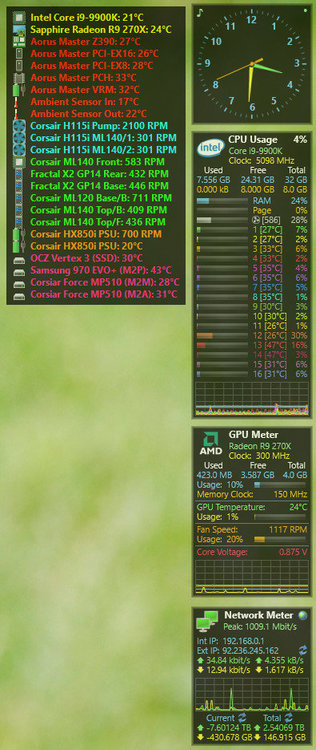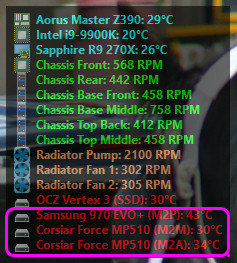
Yemble
-
Posts
17 -
Joined
-
Last visited
Content Type
Profiles
Forums
Events
Posts posted by Yemble
-
-
-
16 hours ago, Fiery said:
The primary IP address is provided by Winsock, and may or may not be the primary network adapter. In rare cases Windows treats one of the least used network adapters as primary. We haven't found a way to fix it from our end.
Yea, only when I disable both virtual NICs does AIDA64 show the correct Primary IP. Oh well, NP, as long as you are already aware of it...
-
I have VmWare Workstation installed on my PC, although I rarely use it. However, I have noticed that AIDA64 displays the Primary IP Address as one of the two VmWare virtual NIC addresses rather than the physical ethernet NIC address of the PC's wired connection.
There does not appear to be any way in AIDA64 to select the correct NIC for the Primary IP Address.
-
80-90C is not unusual for the i9-9900K during stress testing. Note that the default thermal throttling temperature is 100C for this CPU, however, most OC guides that I've read suggest upping this threshold to 110C in the BIOS. Then you should never see throtting within AIDA64 stress testing.
It is not clear to me, from your picture, where you are drawing air into the radiator from. If you can, then the best CPU cooling will be achieved drawing air from outside through a radiator at the front of the case and then exhausting out of the top. You can use PMW case fans to cool the other components.
I cool my i9-9900K with a Corsair H115i AIO in a push-pull config at the front of my case. I can run AIDA64 stress testing all day long overclocked to 5.1GHz / PC3400 without ever seeing any thermal throttling.
-
Works as expected in 6.00.5100.
Cheers

-
I've re-enabled the Asetek monitoring module and no issues with the radiator fans so far. iCUE seems happy as well.
Can AIDA64 capture the coolant temperature sensor data from the H115i Pro, if so, what is the sensor called?
Forget that, I was mis-interpretting Temperature #1 as a mobo sensor, when it was, in fact, the coolant temperature.
Just ran the System Stability Test for two hours, no issues.
-
Sussed it

In the Stability settings, the RAID SMART support option is enabled by default. Disabling this option stops the NVMe drive lines periodically disappearing, but crucially, it does not prevent the drives SMART data from being read, even though two of the drives are in a RST RAID-0 set. Note that I left RAID member enumeration enabled.
This applies to the AIDA64 release version as well as the latest two betas.
-
23 minutes ago, Fiery said:
It will be implemented in the next AIDA64 beta update.
Perfect

-
22 minutes ago, Fiery said:
AFAIK with Asetek-compliant liquid coolers the issue is that the fan controlling logic could get reset when AIDA64 and iCUE collides while reading the liquid cooler measurements. It results in the fans spinning up to 100% speed, which could be quite annoying. If you can live with that limitation, then it's safe to leave the Asetek liquid cooler module enabled in AIDA64.
When I had the Asetek module enabled in AIDA64 I didn't notice any odd effects with the cooler fans. However, because I was still looking for a stable overclock at the time (and having read the Corsair forums), I decided to disable the Asetek module to avoid any possible red-herrings.
Having this cooler info displayed in the OSD is preferable to using iCUE, IMHO, so I'll give it another go, now that I know what to look out for.
If it fails, I'll report back to you...
-
I have both AIDA64 and HWinfo installed on my new i9-9900K water cooled rig, HWinfo for its Rainmeter plugin and AIDA64 for its OSD. My AIO cooler is a Corsair H115i Pro, with the pump speed sensor plugged into the CPU mobo header. The other cooler sensors, temperature and fan speeds, use a dedicated USB connection direct from the pump head. Both HWinfo and AIDA64 can monitor these sensors, but the Corsair forums are full of warnings that doing so will conflict with their iCUE software, resulting in BSOD events. The advice for HWinfo, is to disable Asetek(!) monitoring altogether, for which there is a tick-box, which I did.
I noticed that there is a similar option for Asetek within AIDA64. Am I correct in assuming that it does the same thing, for the same purpose?
I am querying this, as initially I was monitoring the cooler pump and fan speeds (but not the coolant temperature) with AIDA64 and iCUE seemed to work perfectly well, ie. no BSOD. So now I am wondering whether, or not, this is a non-issue?
-
22 hours ago, Fiery said:
Please avoid being arrogant with us on this forum. Please also try to enable the SensorPanel, and check if the Lock panel position option works the way you expect (but for the OSD Panel). If yes, then we can implement that behavior for the OSD Panel as well.
Yep, that's all I'm requesting.
-
22 hours ago, Fiery said:
We've tried to replicate the issue on our own NVMe drives (using the latest AIDA64 beta build), but with no luck. So I cannot check whether there's a difference between the latest stable build (4900) and the latest beta build (4992), since they both work properly for us. But it would be important to find out whether the issue is related to the recent changes that are only available in the last few beta builds.
OK, how odd! I'll give the release version a shot when I get home. What sampling period do you have set for aquiring the drive SMART data? I'm sure I have it on the default setting (whatever that is).
FYI, mobo is a Gigabyte Aorus Master running F9b BIOS.
-
15 hours ago, Fiery said:
1) Can you see the same issue with AIDA64 v5.99.4900, the latest stable release?
2) Are your NVMe drives part of a RAID array?
The two Corsair drives are in a RST RAID-0 set, however, the Samsung EVO is an AHCI Windows 10 OS boot drive. All three NVMe drives are affected, but not the older OCZ Vertex SATA SSD. All three NVMe drives are located directly on the Aorus Master motherboard, if that is relevant.
Not tried the release version, as I had assumed that the beta would be "more advanced". Are you saying that the release version does not exhibit this behaviour?
The thread title suggests that this is related to the aquisition of temperature data, however, I suppose that it is whilst querying the drive's SMART data.
-
23 hours ago, Fiery said:
OSD Panel is supposed to be a quick & easy solution to display sensor readings. If you need a more advanced solution, try AIDA64 SensorPanel which -- among many other things -- supports locking its position and window size.
A disappointing response really. Quick and simple is exactly what I want and SensorPanel is anything but, which is why I am using the OSD. For me, OSD is the superior of the two options. Given that you have gone to the trouble of developing the OSD in the first place, why not complete the job and allow it to be locked on the screen... or is this too much like rocket science?
-
AIDA OSD panel cannot currently be locked on the desktop, which is a PITA.
Why not implement a click-through option, exactly like Rainmeter, whereby mouse clicks are effectively ignored by the OSD, effectively locking it in place? In Rainmeter, CRTL/right-click displays the context menu of the gadget.
Ref. screenshot, Rainmeter gadgets on right cannot be accidentally dragged, whereas AIDA OSD can.
-
I use the OSD for monitoring system temperatures and fan speeds. I find AIDA64 the most convenient of (numerous) hardware monitors for just displaying a text list of specific metrics.
However, I have come across one rather annoying attribute of v5.55.4992b, when listing NVMe drive temps. During each refresh cycle, the line display for my three NVMe drives (a Samsung 970 Evo+ and a couple of Corsair Force MP510s) disappears from the OSD and all of the lines below are shuffled up. A few seconds later, the three NVMe lines re-appear and the subsequent lines shuffle down again. Interestingly, this behaviour does not apply for my single OCZ Vertex SSD drive. Ref. attached snippet. Note that I have deliberately moved the NVMe drives to the bottom of the list to reduce the amount of jumping text!
This is really irritating behaviour and is surely not intentional?
Any chance of fixing this please?




aida64 and icue, commander pro
in Hardware monitoring
Posted
Easy...
Open Services applet (it's within Administative Tools), locate Corsair Service, edit it and change the Startup type to Automatic (Delayed Start)
You maybe correct in saying that this is a CoPro issue as I do not use one of these in my rig (I have zero interest in RGB), however, for me it is just a resource clash during Windows boot. Too many things going for the same hardware at exactly the same time.